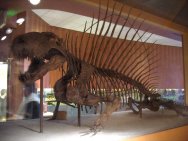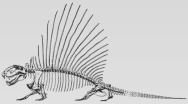Name: Dimetrodon grandis
Phylum Chordata, Subphylum: Vertebrata, Class Synapsida, Order Pelycosauria, Family Sphenacodontidae
Geological Time: Early to Middle Permian
Size: up to about 10 feet long, weighing over 400 pounds
Stratigraphy: North America (Oklahoma, Texas)
Importantly,
the synapsids were the first tetrapods to evolve differentiated
(or heterodont) teeth used to chew food prior to swallowing, enabling
more rapid digestion. As a synapsid, Dimetrodon is a closer ancestor
to modern mammals, including humans, than the sauropsids. Dimetrodon
is placed in order Pelycosauria, a group of synapsids with direct
ancestral linkage to Mammalia, based on the differentiated teeth
and a developing hard palate. |

